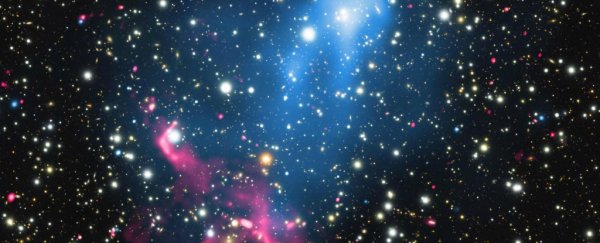An international team of astronomers have discovered a 'cosmic one-two punch' in the night sky that has never been seen before. In one image, the team managed to spot a supermassive black hole and two gigantic galaxy clusters colliding at the same time.
Matter ejected from the black hole gets caught up inside the violent galactic collisions, turning this dynamic duo into one hell of an enormous cosmic particle accelerator.
"We have seen each of these spectacular phenomena separately in many places," said team leader Reinout van Weeren, from the Harvard-Smithsonian Centre for Astrophysics.
"This is the first time, however, that we seen them clearly linked together in the same system."
As if that wasn't enough to awe us, the distance and magnitude of these structures are downright mind-melting.
The colliding galaxy clusters, called Abell 4311 and Abell 3412, are located roughly two billion light years away from Earth. Each is about a quadrillion times more massive than the Sun.
Here's the entire image:
 NASA/CXC/SAO/R. van Weeren et al; Optical: NAOJ/Subaru
NASA/CXC/SAO/R. van Weeren et al; Optical: NAOJ/Subaru
The team was able to pull off such a remarkable observation by combining data collected by many of Earth's high-powered telescopes, such as NASA's Chandra X-ray Observatory, the Metrewave Radio Telescope in India, the Karl G. Jansky Very Large Array, and other telescopes across the globe.
While the image itself is impressive for researchers and the bluish, comet-shaped X-ray emissions in the image are beautiful, the most important aspect of this discovery is how the particles inside the structures are operating.
The team says that the supermassive black hole in the centre of these two behemoths produces a rotating, tightly-wound magnetic funnel that creates a jet of particles outside of it.
These particles, which are already accelerated, then undergo another speed boost as they interact with the massive shock waves produced by the galaxies colliding.
"It's almost like launching a rocket into low-Earth orbit and then getting shot out of the Solar System by a second rocket blast," said co-author Felipe Andrade-Santos, from the Harvard-Smithsonian Centre for Astrophysics.
"These particles are among the most energetic particles observed in the Universe, thanks to the double injection of energy."
This discovery is important because it solves a longstanding debate involving the creation of swirls of radio signals that can stretch out for millions of light years.
The team says that such swirls likely start in systems similar to the one they imaged because the shock waves that are produced in the galaxy clusters take hundreds of millions of years to sweep across all of those particles, causing radio emissions to swirl for vast distances.
"This result shows that a remarkable combination of powerful events generate these particle acceleration factories, which are the largest and most powerful in the Universe," said co-author William Dawson, from the Lawrence Livermore National Lab.
"It is a bit poetic that it took a combination of the world's biggest observatories to understand this."
Hopefully, as our telescopes becoming stronger and stronger, more structures like these will be spotted by astronomers, shining new light on how the Universe works and was created.
The team's work was published in Nature Astronomy.
